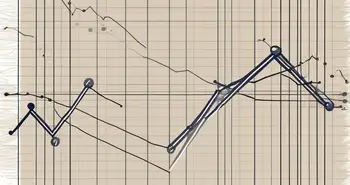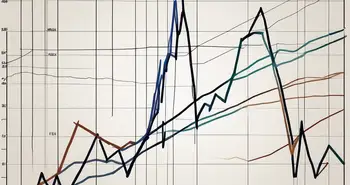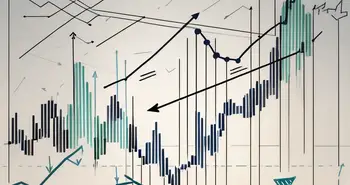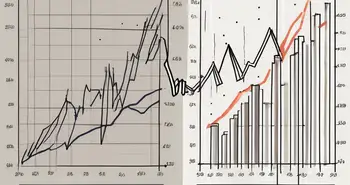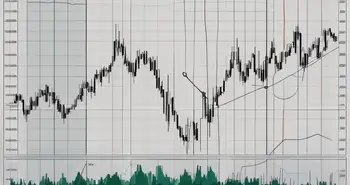What is Divergence in Trading?

As an experienced trader, I understand the importance of staying ahead of the curve in the ever-changing world of financial markets. One concept that has greatly influenced my trading strategies is divergence. In this comprehensive guide, I will walk you through the ins and outs of divergence trading, from its basic concept to advanced strategies that can enhance your trading skills. So, let's dive in!
Defining Divergence in Trading
Before we delve into the various aspects of divergence trading, let's start by understanding what divergence actually means. In simple terms, divergence refers to a discrepancy between an indicator and the price action. It occurs when the price is moving in one direction, while the indicator is moving in the opposite direction. This divergence can provide valuable insights into potential market reversals or trend continuations.
The Basic Concept of Divergence
Divergence is based on the idea that when the price and an indicator are not in sync, it suggests a shift in market sentiment. For instance, if the price is making higher highs, but the indicator is making lower highs, it indicates a bearish divergence. Conversely, if the price is making lower lows, but the indicator is making higher lows, it suggests a bullish divergence.
Types of Divergence in Trading
There are two main types of divergence: regular and hidden. Regular divergence occurs when the price and the indicator move in opposite directions. On the other hand, hidden divergence occurs when the price and the indicator move in the same direction but with different momentum. Both types of divergence can provide valuable trading opportunities, so it's crucial to be able to spot them on your charts.
The Importance of Divergence in Trading
Now that we have a good grasp of what divergence is, let's explore why it is an essential aspect of trading. One of the key benefits of divergence is its ability to predict potential market reversals. By identifying divergences, traders can anticipate trend changes before they occur, providing an edge in their trading decisions.
Predicting Market Reversals
When a divergence occurs, it often points to a weakening trend or a reversal in the opposite direction. By recognizing these divergences, traders can adjust their strategies accordingly, either by exiting their positions or even taking contrarian trades with a view to capturing the upcoming reversal. This predictive power of divergence makes it a valuable tool for traders of all levels.
Enhancing Trading Strategies
Another way in which divergence is important in trading is its ability to enhance existing trading strategies. By incorporating divergence analysis into your trading approach, you can confirm trade signals and filter out false ones. This additional level of confirmation can significantly improve the accuracy of your entries and exits, leading to more profitable trades.
Identifying Divergence on Trading Charts
Now that we understand the significance of divergence, let's shift our focus to how we can spot it on our trading charts. There are two primary forms of divergence that we need to be able to recognize: regular divergence and hidden divergence.
Spotting Regular Divergence
To identify regular divergence, we need to compare the peaks and troughs on the price chart with those on the indicator chart. Regular bearish divergence occurs when the price makes higher highs, but the indicator makes lower highs. Conversely, regular bullish divergence occurs when the price makes lower lows, but the indicator makes higher lows. Keep an eye out for these patterns, as they can be early signs of a potential trend reversal.
Recognizing Hidden Divergence
Hidden divergence can be a little trickier to spot, but it is equally important. Hidden bearish divergence occurs when the price makes lower lows, but the indicator makes higher lows. Conversely, hidden bullish divergence occurs when the price makes higher highs, but the indicator makes lower highs. These patterns often indicate a continuation of the current trend rather than a reversal. By identifying hidden divergence, traders can stay on the right side of the trend and capitalize on ongoing market movements.
The Role of Oscillators in Divergence Trading
While divergence can be observed with various indicators, oscillators are particularly useful tools for identifying these patterns. Two popular oscillators that are frequently used for divergence analysis are the Relative Strength Index (RSI) and the Moving Average Convergence Divergence (MACD).
Understanding the Relative Strength Index (RSI)
The RSI is a commonly used oscillator that measures the speed and change of price movements. When it diverges from the price action, it can indicate potential reversals. Understanding how the RSI works and how to interpret its divergence signals can provide valuable insights for your trading decisions.
Utilizing the Moving Average Convergence Divergence (MACD)
The MACD is another powerful oscillator that combines moving averages to identify potential trend changes. Divergence signals on the MACD can act as early warnings of trend reversals or continuations. Learning how to effectively use the MACD in conjunction with divergence analysis can greatly enhance your trading strategy.
Divergence Trading Strategies
Now that we have covered the basics of divergence trading, let's explore some strategies that you can apply to your trading approach. While divergence alone can provide valuable insights, combining it with other indicators can further strengthen your trading decisions.
Combining Divergence with Other Indicators
One powerful way to leverage divergence analysis is by combining it with other indicators, such as trendlines or support and resistance levels. These additional tools can help confirm or invalidate divergence signals, providing a more comprehensive view of the market. Experimenting with different combinations can help you find a strategy that suits your trading style and preferences.
Risk Management in Divergence Trading
As with any trading strategy, risk management is paramount when trading divergence. Setting appropriate stop-loss levels and position sizes can help protect your capital in case a trade does not go as expected. Additionally, it's essential to continuously monitor and adjust your risk parameters as market conditions change. By effectively managing risk, you can ensure the long-term sustainability of your trading endeavors.
Through my years of experience as a trader, I have learned that mastering the art of divergence can significantly enhance your trading performance. By utilizing the power of divergence analysis, you can gain valuable insights into potential market reversals, improve your trading strategies, and grow as a trader. So, embrace the concept of divergence and start incorporating it into your trading toolbox.
FAQ
Q: What is divergence in trading?
A: Divergence refers to a discrepancy between an indicator and the price action, suggesting potential market reversals or trend continuations.
Q: How can I identify regular divergence?
A: Regular bearish divergence occurs when the price makes higher highs, but the indicator makes lower highs. Regular bullish divergence occurs when the price makes lower lows, but the indicator makes higher lows.
Q: What is hidden divergence?
A: Hidden divergence occurs when the price and the indicator move in the same direction but with different momentum. Hidden bearish divergence occurs when the price makes lower lows, but the indicator makes higher lows. Hidden bullish divergence occurs when the price makes higher highs, but the indicator makes lower highs.
Q: Which oscillators can be used for divergence analysis?
A: Popular oscillators for divergence analysis include the Relative Strength Index (RSI) and the Moving Average Convergence Divergence (MACD).
Q: How can I incorporate risk management in divergence trading?
A: It is crucial to set appropriate stop-loss levels and position sizes based on your risk tolerance. Continuously monitor and adjust your risk parameters as market conditions change.
Remember, mastering divergence takes practice and experience. However, with dedication and a deep understanding of this concept, you can significantly improve your trading decisions and take your trading skills to new heights.
Ready to put your newfound knowledge of divergence trading into action? Look no further than Morpher, the revolutionary trading platform that leverages blockchain technology to offer you a seamless and innovative trading experience. With Morpher, you can trade across a multitude of asset classes with zero fees, infinite liquidity, and the option for fractional investing. Embrace the power of divergence with the safety and control of a non-custodial wallet, and take advantage of up to 10x leverage to amplify your trades. Don't miss out on the opportunity to transform your trading strategy. Sign Up and Get Your Free Sign Up Bonus today, and join the community of traders who are already experiencing the future of investing with Morpher.

Disclaimer: All investments involve risk, and the past performance of a security, industry, sector, market, financial product, trading strategy, or individual’s trading does not guarantee future results or returns. Investors are fully responsible for any investment decisions they make. Such decisions should be based solely on an evaluation of their financial circumstances, investment objectives, risk tolerance, and liquidity needs. This post does not constitute investment advice.

Painless trading for everyone
Hundreds of markets all in one place - Apple, Bitcoin, Gold, Watches, NFTs, Sneakers and so much more.

Painless trading for everyone
Hundreds of markets all in one place - Apple, Bitcoin, Gold, Watches, NFTs, Sneakers and so much more.


